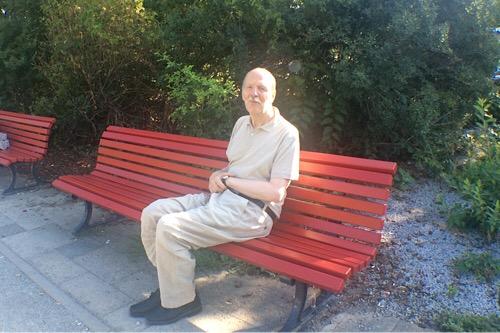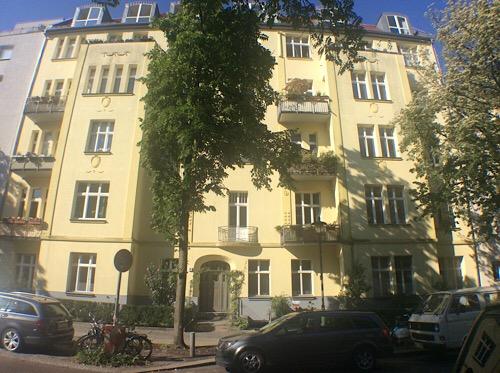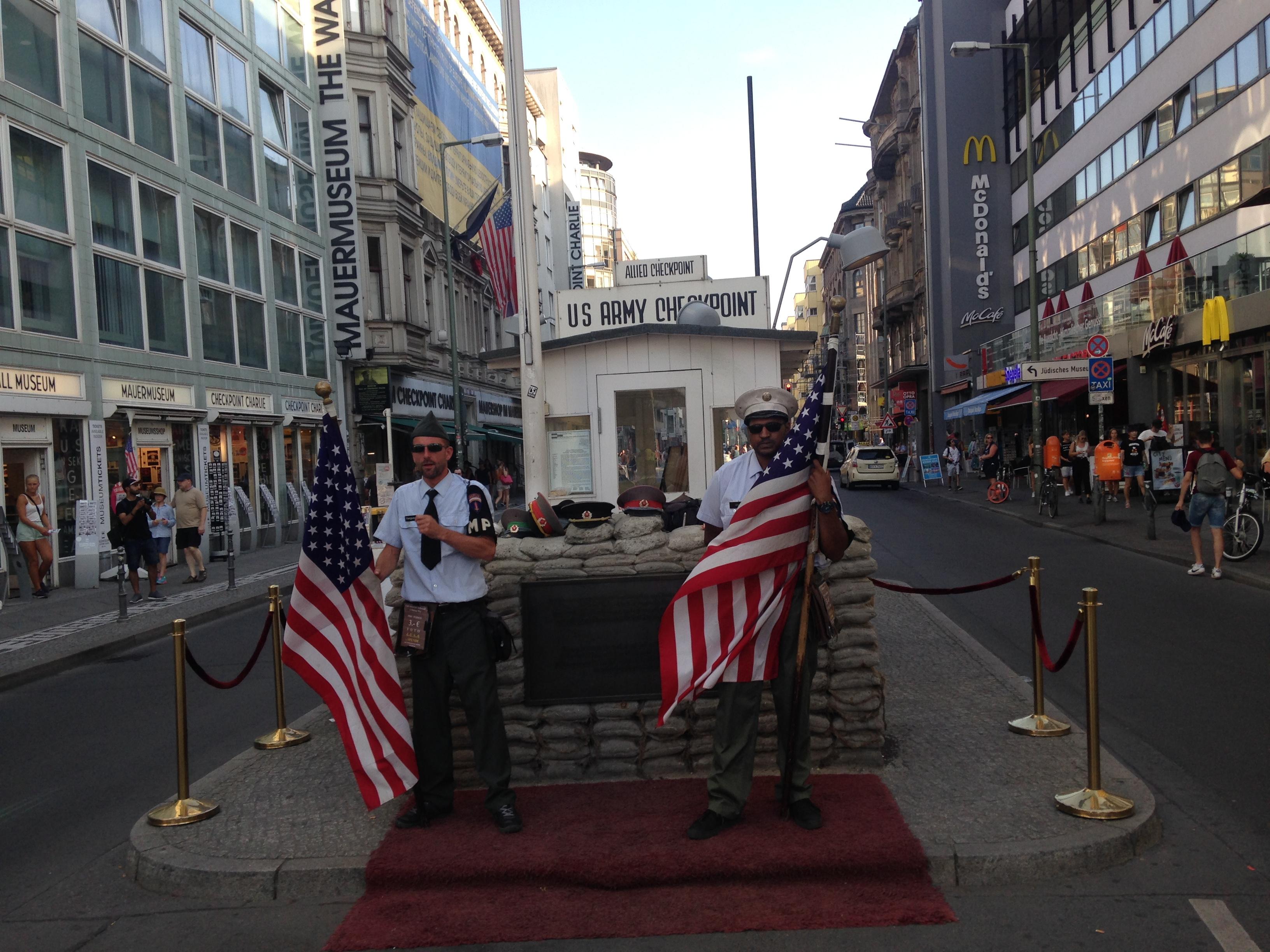Day 6: Berlin topograpies
One of the books I read before leaving on this trip was a slim but satisfying, recently published volume called Berlin for Jews, a Twenty-First Century Companion by Leonard Barkam. Rather than try to comprehensively cover everything about the subject, the author focuses his attention on just two locations and three people who shaped the city’s Jewish history. Through these five subjects, Barkam is able to paint a larger mosaic that allows him to muse about the city’s glorious past and its rebirth as a center of Jewish culture.
One of the locations he covers is the Bayerische Viertal (Bavarian Quarter), a section within the Schöneberg district south of the Tiergarten residential district. I had already noted that the area was fairly near to my Halensee base and had it on my list of possible visits. But when I mapped the addresses of our two Katz ancestors—Betty Wohlgemuth and her cousin Amalie Katz, discussed in yesterday’s post—I found both of them within a few blocks of the Bayerische Platz, the center of the quarter. So I decided to make that my first stop for the day.
The Bayerische Viertal has long been known in Berlin as the Jewish Switzerland, an upper middle class neighborhood of leafy residential streets and stately apartment buildings. Back in the day, the area was home to 16,000 Jews, and it was here according to Barkam that German Jewish culture achieved it greatest heights. Most Jews retained their religious identity but they also assimilated into the surrounding culture and were as proud to call themselves German as they were of their Mosaic faith.
Residents like Hannah Arendt, Walter Benjamin and Albert Einstein were at home here. And so were our two Katz ancestors, even as late as the 1940s, where they continued to live their comfortable lifestyles even as the Nazi persecutions rained down in the neighborhood and across the city.
More about our relatives in a minute, but before proceeding to their addresses I wanted to take in the Platz itself. It was a typical Berlin public square occupying about four city blocks with streets angling off in all directions. There was a fountain, well-tended flowerbeds and walking paths. After taking some pictures, I took a seat on a bench to breathe in the scene. (Among the other indignities during the dark period, these same benches had once been banned to Jews.)
An older gentleman approached me and was interested in my camera setup. When I showed him it was just an iPad snapped into a frame, he nodded, explaining he uses an older cell phone and is not very good with computers. His name was Wolfgang and we fell into talking. Despite having suffered a stroke a few years ago, his English was better than my German so we proceeded in that language.
Wolfgang was born in 1947 in the south of Germany but lived here since finishing high school in the early 1960s. His father fought in and survived Germany’s great defeat in Stalingrad, but Wolfgang had little taste for anything about the Nazis and the Third Reich. He said this place was developed during the Second Reich under Kaiser Wilhelm, a period of greatness for the German nation.
He was most proud to point out that it was at the Schöneberg Rathaus (town hall), just a few blocks south of the Platz, where JFK made his famous Berliner speech in 1963. That led to a discussion of current world affairs, including of the ways Trump is like and unlike Hitler. He is no fan of America’s current politics, citing the environment and trade as two areas where the U.S. has abdicated leadership. He was glad to find that I shared his opinion on that subject, and also on the damage that Netanyahu has done to Israel’s reputation in the world.
I told him about my relations and what had happened to them here. He commiserated and remarked that I was not the first family historian he has met here in the Platz. Many people come here searching for their Jewish roots in Berlin.
I would have liked to engage him further about German politics and especially the migrant crisis, but I needed to hurry on. He directed me to Landshuter Straße, running due north from the platz, and also pointed out Aschaffenburger Straße angling off to the northwest. Both these streets are named for Bavarian towns, Wolfgang said with some pride that the region of his birth is thusly honored in the Prussian capital city that is his adopted home.
Taking my leave, I went first looking for Landshuter Str. 13, where Amalie lived. Unfortunately, it is the one building on the street that is no longer there. Numbers 12 and 14 bookend a small playground, or Spielplatz, that a sign informed me had been erected in 1997. If we wanted to sponsor a Stolpersteine for Amalie, it would have to go on the sidewalk in from of the playground.
The other buildings on the street are all handsome Berlin apartments, built presumably in about 1910 when the quarter was developed by a Jewish developer. No doubt Landshuter 13 was the same at one time.
Around to the other side of the playground running at an angle is Aschaffenburger Str., where Betty lived at No. 6. This yellow-painted building remains, again with elegant proportions and decidedly upscale as it no doubt was in Betty’s time. I took my photos and recorded video there, then looked at the listing of resident names by the door and was happy to see several Jewish names among them. It is about two miles as the crow flies from here to the Ringel apartment in Charlottenburg, or a little more on foot or by bus.
I was surprised to see only a few Stolpersteine in the blocks around the neighborhood, but then I saw that the Bayerische Viertal has its own unique kind of memorial to the Jewish experience here in the Nazi era. Attached to lampposts all around the quarter are 80 simply designed but stunning effective, two-sided signs listing an obnoxious Nazi anti-Jewish regulation and the date it was promulgated. On the other side is a graphic image depicting that affront.
For example, on Betty’s street is one stating (in German) “Occupational ban of actresses and actors, March 5, 1934.” On the reverse is a bright red theater curtain, fully closed to represent one more loss of economic opportunity to Jews in Berlin. These stark reminders are a different type of memorial from the sidewalk stones, but both serve as constant in-your-face reminders of the terrible things that happened here.
By the time I got back to the apartment to freshen up and enjoy a quarter watermelon that I picked up (the heat and humidity are still oppressive), I realized that visiting the Landesarchiv today as planned was not in the cards. By the time I got there I would have only a few hours before closing time to conduct research, So that will have to happen tomorrow.
Instead I decided to visit another historical attraction, if you can call it that, that was on my list. The Topography of Terror exhibition and document center stands on the site of the old Gestapo headquarters and Reich security office. From the outside it is a stark, low-slung, black metal building centered on a massive square of crushed rocks. The exhibit is indoors and out, and I started by taking in the football-field length display of chronological events of the year 1933, when Hitler was given power and he exercised it ruthlessly. The display is sited along the east end of the square, hard up against the former route of the Berlin Wall.
There was a lot of great information there but nothing that cannot be found in other sources. The real treasure is inside the building in what they call the document Center. Here too are extensive information panels with photos and captions covering the sordid history of the Gestapo, SS, SD, RHSA and all the other instruments of persecution. Here are all the war criminals—Himmler, Heydrich, Kaltenbrunner, Eichmann, Müller and the rest. One personality of fascination to me is Artur Nebe, a recurring character in the Bernie Gunther books who was the chief of Berlin’s criminal police (Kripo) before taking command of Einsatzgruppen B, the mobile killing squad that murdered tens of thousands in Belarus and Lithuania. How this respectable lawyer and professional police administrator turned into a mass murderer has been one of those inexplicable things I’ve grappled with, but here you begin to understand how otherwise reasonable people were sucked into the system.
The star of the show for me were the documents. They weren’t the originals, of course, but the exhibit has page after page of incriminating evidence—memos, lists, IBM cards, the Wannsee Conference report and so much more. You can’t help but be overwhelmed with the brazen openness with which this criminal regime undertook its dirty work. Nor can you come away with any conclusion other than that most of the perpetrators came out of it with insufficient consequences. A handful received death sentences; most served no more than a few years time before being excused. Far too many of them ended up with jobs in the West German government, all the way up to Konrad Adenauer’s chief of staff Hans Moltke, who was implicated in the atrocities in Greece yet served as Der Alte’s chief of staff all the way into the 1960s.
The beauty of the exhibit is that it lays bare the details of the government’s evil doings for all to see. That includes the thousands of today’s German citizens, many descended from participants in this history, that tour the exhibit in droves every day. At this exhibit and at memorials all over the city, there seems to be a willingness—or even desire—to face up to the facts and own up to a national collective responsibility. That’s encouraging.
I came out of the Topography of Terror exhibit mentally exhausted and ready to turn the page to another chapter in history. The famous Checkpoint Charlie, the inter zone border crossing where the U.S. and allies faced off against the Soviets in a number of tense episodes during the 1960s, was exactly one block to the south. As gripping as was the Terror exhibit, the whole scene around the checkpoint was disturbingly superficial, reminiscent of any tourist trap from Time Square to Gatlinburg. Actors in military dress mugging with the tourists for money. Chintzy museums and attractions. Soviet uniforms and paraphernalia is cheesy little tourist shops. (Fortunately it is against the law to sell Nazi regalia, but there is no limit to the amount of fake Russian gear on offer.)
There is still much to be learned and experienced in this undoubtedly important location, but it is hard to find amidst the all the junk history. I got my fill of it pretty quickly and caught the bus west into the heart of the shopping district.
Normally I don’t like going to department stores, and it would probably be low on my list to take in high-end shopping venues on an international trip. But department stores are an integral part of the history of Jewish commerce in Berlin, including the Nazi repressions that dispossessed Jewish retailers of their property.
The most famous department store in Berlin today, the Kaufhaus des Westens, universally known as KaDeWe, was owned in the 1920s and half of the 30s by the Jewish merchant Hermann Tietz. Like many institutions in Berlin, it was all but destroyed in the war and only slowly revived afterwards. In the decades since the fall of the Berlin Wall, however, it has returned to or likely surpassed its former glory, with eight floors of dedicated to the culture of consumerism.
Also, all the Berlin guidebooks list its gourmet food emporium on the sixth floor as a top choice for dining on the cheap in the city. So I took the M29 bus to the Wittenberg Platz and entered the famous store. On the lower level, every exclusive design label you can name had its own boutique. Of course the place smelled like every other department store in the world, a combination of perfumeries meant to seduce normally prudent people into the spirit of spending. I rode the escalators up, stopping on the menswear floor to see what I could find to replace my ripped shirt from the cemetery. Even though many racks were labeled as 50% off, I didn’t see anything I wanted for less than 50€ so I didn’t stay long.
Then I went up to the food level. Here the aromas were more to my liking as I browsed every imaginable kind of luscious food stall. The smoked fish counter looked especially good, though I wasn’t here for take-home delicacies, but for the equally enticing selection of restaurants. Every kind of cuisine was represented but today I was looking today for traditional German fare, which I had not yet sampled in the city. There were several good choices but by the time I had made up my mind it was just past 8 pm, 20 Uhr on the German clock. As I sat down at the counter and asked for a menu, the server told me with apologies that food service throughout the store closes at 8. I had just missed the deadline.
No biggie. Although everything in the store looked enticing, the prices were not as good as promised in the guidebooks, and there is no shortage of hearty German food on just about every block in the city. I walked down the boulevard back to the corner of Schlüterstrße, where I enjoyed my first strictly German food, a schnitzel plate with salad and potatoes, along with a half-liter of well-deserved Pilsner.
While on the corner of KuDamm where our ancestors probably walked by every day, I tried to find a sidewalk paving pattern that resembles the layout in the picture that we have of Hermann and Helga walking on the boulevard. So much has changed since that time in Berlin but the sidewalks in this case seem unchanged. The photo shows a section of sidewalk on Schlüterstraße on the block north of KuDamm, which is very close to what we see in the photo from the early 1930s.
Then I hopped a bus. Then I hopped a bus down the KuDamm to Halensee and tucked myself in after another long day.





